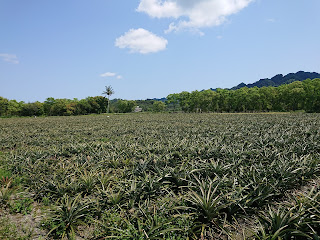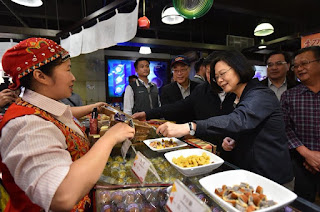My job is not a tour guide, but to support
the revival of the tourism industry in Hualien, I have been playing this role
diligently recently, vigorously promoting and recruiting friends to visit and
tour Hualien. Following the presidential
tour that was a gesture to assure the public of the safety and sustaining
beauty of Hualien after the earthquake, my staff immediately started organizing
the next official tourism inspection tour of Premier Lai 賴清德院長.
There are plenty of places to visit in
Hualien, but the first challenge was to organize an itinerary that was
different from that of President Tsai’s, introducing lesser-known sites and
locations to the Premier and his press team. His Hualien tourism promotion delegation spent two days, April 14-15, 2018 in Hualien.
The first stop was at the historic
General’s Residence 將軍府, situated right in the middle of Hualien
City. There is no record of any actual
general ever living there, but the row of eight Japanese era wooden houses
acquired its name as the General’s Residence because they once housed the
Japanese commander of eastern Taiwan, and right across the street in what is
today’s Military Police camp ground, the former war prisoner camp where US Pacific
War General Jonathan Wainwright, along with other senior military leaders of
the Allied Forces, was once incarcerated.
Ownership of the Generals Residence and surrounding cluster of
dilapidated old wooden houses remain with the Taiwan Ministry of National
Defense, but since the houses have been designated cultural assets,
refurbishing and renovation is to be expected with the support of the Ministry
of Culture.
 |
| The General's Residence, in the center of Hualien City |
 |
| A row of old Japanese era military residence houses awaiting renovation |
Here we ran into a travel journalist of the
South China Morning Post, who happened to be writing about Hualien travel and
tourism. I certainly hope that such
sites of historic and cultural meaning will interest visitors from Hong Kong and
elsewhere.
To support unique one-of-a-kind local
brands and old shops, next we visited the New Taste Soy Sauce Factory 新味醬油工廠, a ninety-year soy sauce producer in the old town section of
Hualien. Here you can find hand-made soy
sauce fermented in complete traditional style, fermented tofu, and soy sauce
produced using Deep Sea Water, also a unique product and gift of Hualien’s
oceanic resources. At its peak, there
were several dozen soy sauce producers in Hualien, especially during the age
when transportation difficulties made bringing in such products from other
counties too costly. But trends in mass
production in the food processing industry, plus increasing transportation
conveniences brought in low-cost competition from elsewhere, putting all but
one traditional soy sauce producer out of business. Now the shop is run by its third generation
owner, carrying on the value of their products by an insistence on hand-made,
no added-chemicals gourmet quality. Here
all the journalists each got a bottle of soy sauce as a gift from Premier Lai.
 |
| New Taste Soy Sauce Factory |
 |
| An old Hakka style home on display in the museum |
Our first afternoon started with a tour of
the Hakka Culture Museum 客家文物館of Fenglin
Township 鳳林鎮, a town in central Hualien whose
residents are mostly Hakka and Amis.
Though not very large, here we found displays of the history of
migration of Hakka people to this region, and relics of traditional Hakka
lifestyle and culture. For a small-town
museum, it is not common to find English language introductions of the various
displays. Obviously, this town which was
the first Taiwanese town to join Cittaslow -- a movement of small towns
celebrating a slower traditional lifestyle -- is eager to be seen
internationally.
Next to the Hakka Culture Museum is the
natural fabric dye workshop. Here
community volunteers will introduce visitors to natural dyes of assorted herbs
and leaves, and various patterns and ways of creating fabric designs. Premier Lai chose a brown dye made of onion
skin, while I chose a yellow dye of a specific cooked leaf. We experimented with a blank white square
fabric, but at the shop there are also selections of do-it-yourself white
t-shirts or scarves. Already made,
naturally dyed cotton or silk scarves are available for sale here. A few cats roaming around the workshop and
its surroundings were quite friendly, posing for photos with the press corps as
we boiled and dyed our fabrics.
 |
| Community volunteers explaining the source of natural fabric dyes |
A favorite stop for visitors, especially on
a warm spring afternoon, is the Taiwan Sugar Company factory in Guangfu
Township 光復糖廠.
At the center of rural Hualien, the sugar company owns most of the farm
land in the region, producing sugarcane in the past, and now just simply
renting out to tenant farmers. For
decades, the sugar factory was a center of economic activity in central
Hualien. But ever since sugarcane phased
out as a competitive crop for Taiwan, the factory made a transition to selling
ice cream. It gets hundreds of thousands
of stop-over visitors each year for a bowl of vanilla ice cream topped with
red beans, a Taiwanese favorite. With a
reservation, visitors can get a traditional taste of how sugar is made: Extracting juice from the sugarcane, cooking
the juice until it forms a dark brown syrup, then quickly stirring the syrup as
it cools until the color turns light and transforms into powder. Voila, your all-natural brown sugar!
 |
| Extracting juice from the sugarcane. |
 |
| Sugarcane juice is heated then rapidly stirred, turning into a brown powder sugar. |
Next to the ice cream stand are several
dozen Japanese houses, formerly dormitories for factory workers and staff, now
renovated into delicate traditional Japanese-style hotel rooms. Reservations can be made through the sugar
factory: http://www.hualiensugar.com.tw/
We had a feast at a traditional Amis
restaurant, at the Red Tile House 紅瓦屋, located in the
Fataan Tribal lands next to natural marshes.
This rustic restaurant which showcases various sculptures and wood
carvings of its Amis owners, was the site of a state banquet hosted by former
President Chen for the President of the Marshall Islands in 2008. It is indeed worthy of a state banquet,
serving delicious and unique Amis indigenous dishes of a wild vegetable salad,
Amis ham Silaw 鹹豬肉, salt-caked baked fish, and the
feature dish: a stone hot pot. No, you
do not eat the stones. A large bowl made
of betel nut husks, containing raw fish, vegetables, and cold water is brought
to the table. Then hot burning stones as
hot as 800 degrees are quickly added to the raw soup, producing a hot sizzling
steam in the process. The fish is
cooked, producing a tasty clear broth.
Obviously, this particular dish requires a reservation in advance. Heating the stones does take time.
Guangfu Township is about an hour’s drive back
to Hualien City, where Premier Lai and his advisors stayed for the night at
Kadda, a hotel at the oceanfront in the Meilun 美崙district of Hualien. Kadda is
a trendy hotel designed to accommodate sports lovers and cyclists, with racks
in each room to store bicycles for various competitions and enjoyment in
Hualien. Every room looks over the Port
of Hualien 花蓮港 and the vast Pacific Ocean. The Italian restaurant, Bella Cibo on the
first floor offers an elegant dining option. One of the most attractive features in the
hotel is its swimming pool, though not large in size, its design allows a
view directly into the Pacific Ocean. Reservations can be made through various international
hotel booking websites, or directly at http://www.kaddahotel.com/
 |
| Photo from trendy sports-supporting Kadda Hotel website |











留言
張貼留言